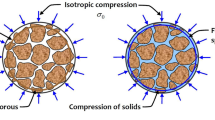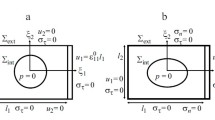Abstract
Reservoir porous rocks usually consist of more than two types of matrix materials, forming a randomly heterogeneous material. The determination of the bulk modulus of such a medium is critical to the elastic wave dispersion and attenuation. The elastic moduli for a simple matrix-inclusion model are theoretically analyzed. Most of the efforts assume a uniform inclusion concentration throughout the whole single-material matrix. However, the assumption is too strict in real-world rocks. A model is developed to estimate the moduli of a heterogeneous bimaterial skeleton, i.e., the host matrix and the patchy matrix. The elastic moduli, density, and permeability of the patchy matrix differ from those of the surrounding host matrix material. Both the matrices contain dispersed particle inclusions with different concentrations. By setting the elastic constant and density of the particles to be zero, a double-porosity medium is obtained. The bulk moduli for the whole system are derived with a multi-level effective modulus method based on Hashin’s work. The proposed model improves the elastic modulus calculation of reservoir rocks, and is used to predict the kerogen content based on the wave velocity measured in laboratory. The results show pretty good consistency between the inversed total organic carbon and the measured total organic carbon for two sets of rock samples.
Similar content being viewed by others
References
Gassmann, F, Uber die elastizitat poroser medien. Uber die elastizitat poroser medien 96, 1–23 (1961)
Biot, M. A, Theory of propagation of elastic waves in a fluid-saturated porous solid: 2 higher frequency range. Theory of propagation of elastic waves in a fluid-saturated porous solid: 2 higher frequency range 28, 179–191 (1956)
Biot, M. A, Theory of propagation of elastic waves in a fluid-saturated porous solid: 1 lowfrequency range. Theory of propagation of elastic waves in a fluid-saturated porous solid: 1 lowfrequency range 28, 168–178 (1956)
Biot, M. A, Mechanics of deformation and acoustic propagation in porous media. Mechanics of deformation and acoustic propagation in porous media 33, 1482–1498 (1962)
Pride, S. R., Berryman, J. G., and Harris, J. M, Seismic attenuation due to wave-induced flow. Seismic attenuation due to wave-induced flow 109, 59–70 (2004)
Carcione, J. M., Morency, C., and Santos, J. E, Computational poroelasticity: a review. Computational poroelasticity: a review 75, A229–A243 (2010)
Arntsen, B. and Carcione, J. M, Numerical simulation of the Biot slow wave in water-saturated Nivelsteiner sandstone. Numerical simulation of the Biot slow wave in water-saturated Nivelsteiner sandstone 66, 890–896 (2001)
Dvorkin, J., Mavko, G., and Nur, A, Squirt flow in fully saturated rocks. Squirt flow in fully saturated rocks 60, 97–107 (1995)
Mochizuki, S, Attenuation in partially saturated rocks. Attenuation in partially saturated rocks 87, 8598–8604 (1982)
White, J. E, Computed seismic speeds and attenuation in rocks with partial gas saturation. Computed seismic speeds and attenuation in rocks with partial gas saturation 40, 224–232 (1975)
White, J. E., Mihailova, N., and Lyakhovitsky, F, Low-frequency seismic-waves in fluid-saturated layered rocks. Low-frequency seismic-waves in fluid-saturated layered rocks 57, 654–659 (1975)
Dutta, N. C. and Odé, H, Attenuation and dispersion of compressional waves in fluid-filled porous rocks with partial gas saturation (White model): part I, Biot theory. Attenuation and dispersion of compressional waves in fluid-filled porous rocks with partial gas saturation (White model): part I, Biot theory 44, 1777–1788 (1979)
Dutta, N. C. and Odé, H, Attenuation and dispersion of compressional waves in fluid-filled porous rocks with partial gas saturation (White model): part 2, results. Attenuation and dispersion of compressional waves in fluid-filled porous rocks with partial gas saturation (White model): part 2, results 44, 1789–1805 (1979)
Johnson, D. L, Theory of frequency dependent acoustics in patchy-saturated porous media. Theory of frequency dependent acoustics in patchy-saturated porous media 110, 682–694 (2001)
Ba, J., Carcione, J. M., and Nie, J. X, Biot-Rayleigh theory of wave propagation in double-porosity media. Biot-Rayleigh theory of wave propagation in double-porosity media 116, 309–311 (2011)
Mavko, G. and Nur, A, Melt squirt in the asthenosphere. Melt squirt in the asthenosphere 80, 1444–1448 (1975)
Mavko, G. M. and Nur, A.Wave attenuation in partially saturated rocks. Geophysics, 44, 161–178 (1979)
Toms, J., Müler, T. M., Ciz, R., and Gurevich, B, Comparative review of theoretical models for elastic wave attenuation and dispersion in partially saturated rocks. Comparative review of theoretical models for elastic wave attenuation and dispersion in partially saturated rocks 26, 548–565 (2006)
Müler, T. M., Gurevich, B., and Lebedev, M, Seismic wave attenuation and dispersion resulting from wave-induced flow in porous rocks: a review. Seismic wave attenuation and dispersion resulting from wave-induced flow in porous rocks: a review 75, A147–A164 (2010)
Rubino, J. G. and Holliger, K, Seismic attenuation and velocity dispersion in heterogeneous partially saturated porous rocks. Seismic attenuation and velocity dispersion in heterogeneous partially saturated porous rocks 188, 1088–1102 (2012)
Berryman, J. G. and Wang, H. F, The elastic coefficients of double-porosity models for fluid transport in jointed rock. The elastic coefficients of double-porosity models for fluid transport in jointed rock 100, 24611–24627 (1995)
Pride, S. R. and Berryman, J. G, Linear dynamics of double-porosity dual-permeability materials: I, governing equations and acoustic attenuation. Linear dynamics of double-porosity dual-permeability materials: I, governing equations and acoustic attenuation 68, 141–158 (2003)
Berryman, J. G. and Wang, H. F, Elastic wave propagation and attenuation in a double-porosity dual-permeability medium. Elastic wave propagation and attenuation in a double-porosity dual-permeability medium 37, 63–78 (2000)
Müler, T. M. and Gurevich, B. A first-order statistical smoothing approximation for the coherent wave field in random porous random media. Journal of the Acoustical Society of America, 117, 1796–1805 (2005)
Müler, T. M. and Gurevich, B, Wave-induced fluid flow in random porous media: attenuation and dispersion of elastic waves. Wave-induced fluid flow in random porous media: attenuation and dispersion of elastic waves 117, 2732–2741 (2005)
Müler, T. M. and Gurevich, B, Effective hydraulic conductivity and diffusivity of randomly heterogeneous porous solids with compressible constituents. Effective hydraulic conductivity and diffusivity of randomly heterogeneous porous solids with compressible constituents 88, 121924 (2006)
Carcione, J. M. and Picotti, S. P-wave seismic attenuation by slow-wave diffusion: effects of inhomogeneous rock properties. Geophysics, 71, O1–O8 (2006)
Ba, J., Carcione, J. M., and Nie, J. X, Biot-Rayleigh theory of wave propagation in double-porosity media. Biot-Rayleigh theory of wave propagation in double-porosity media 116, 309–311 (2011)
Ba, J., Carcione, J. M., and Sun, W, Seismic attenuation due to heterogeneities of rock fabric and fluid distribution. Seismic attenuation due to heterogeneities of rock fabric and fluid distribution 202, 1843–1847 (2015)
Quintal, B., Steeb, H., Frehner, M., and Schmalholz, S. M, Quasi-static finite element modeling of seismic attenuation and dispersion due to wave-induced fluid flow in poroelastic media. Quasi-static finite element modeling of seismic attenuation and dispersion due to wave-induced fluid flow in poroelastic media 116, 200–216 (2011)
Sun, W., Ba, J., Müler, T. M., Carcione, J. M., and Cao, H, Comparison of P-wave attenuation models due to wave-induced flow. Comparison of P-wave attenuation models due to wave-induced flow 63, 378–390 (2014)
Eshelby, J. D, The determination of the elastic field of an ellipsoidal inclusion and related problems. The determination of the elastic field of an ellipsoidal inclusion and related problems 241, 376–396 (1957)
Hashin, Z, The elastic moduli of heterogeneous materials. The elastic moduli of heterogeneous materials 29, 143–150 (1962)
Hill, R, Elastic properties of reinforced solids: some theoretical principles. Elastic properties of reinforced solids: some theoretical principles 11, 357–372 (1963)
Brown, W. F, Solid mixture permittivities. Solid mixture permittivities 23, 1514–1517 (1955)
De Loor, G. P, Dielectric properties of heterogeneous mixtures with a polar constituent. Dielectric properties of heterogeneous mixtures with a polar constituent 11, 310–320 (1964)
Hashin, Z. and Shtrikman, S. A variational approach to the theory of the elastic behaviour of polycrystals. Journal of the Mechanics and Physics of Solids, 10, 343–352 (1962)
Hashin, Z. and Shtrikman, S. A variational approach to the theory of the elastic behaviour of multiphase materials. Journal of the Mechanics and Physics of Solids, 11, 127–140 (1963)
Budiansk, B, On elastic moduli of some heterogeneous materials. On elastic moduli of some heterogeneous materials 13, 223–227 (1965)
Hill, R. A self-consistent mechanics of composite materials. Journal of the Mechanics and Physics of Solids, 13, 213–222 (1965)
Zimmerman, R. W, Elastic-moduli of a solid with spherical pores: new self-consistent method. Elastic-moduli of a solid with spherical pores: new self-consistent method 21, 339–343 (1984)
Mori, T. and Tanaka, K, Average stress in matrix and average elastic energy of materials with misfitting inclusions. Average stress in matrix and average elastic energy of materials with misfitting inclusions 21, 571–574 (1973)
Voigt, W. Lehrbuch der Kristallphysik, B. G. Teubner, Berlin (1910)
Reuss, A, Berechnung der flie grenze von mischkristallen auf grund der plastizitäts bedingung fu? r einkristalle. Berechnung der flie grenze von mischkristallen auf grund der plastizitäts bedingung fu? r einkristalle 9, 49–58 (1929)
Hill, R, The elastic behaviour of a crystalline aggregate. The elastic behaviour of a crystalline aggregate 65, 349–354 (1952)
Peselnick, L. and Meister, R, Variational method of determining effective moduli of polycrystals: (A) hexagonal symmetry, (B) trigonal symmetry. Variational method of determining effective moduli of polycrystals: (A) hexagonal symmetry, (B) trigonal symmetry 36, 2879–2884 (1965)
Watt, J. P, Hashin-Shtrikman bounds on the effective elastic-moduli of polycrystals with orthorhombic symmetry. Hashin-Shtrikman bounds on the effective elastic-moduli of polycrystals with orthorhombic symmetry 50, 6290–6295 (1979)
Watt, J. P. and Peselnick, L, Clarification of the Hashin-Shtrikman bounds on the effective elasticmoduli of polycrystals with hexagonal, trigonal, and tetragonal symmetries. Clarification of the Hashin-Shtrikman bounds on the effective elasticmoduli of polycrystals with hexagonal, trigonal, and tetragonal symmetries 51, 1525–1531 (1980)
Budiansky, B. and Oconnell, R. J, Elastic-moduli of a cracked solid. Elastic-moduli of a cracked solid 12, 81–97 (1976)
Burridge, R. and Keller, J. B, Poroelasticity equations derived from microstructure. Poroelasticity equations derived from microstructure 70, 1140–1146 (1981)
Xu, S. Y. and White, R. E. A new velocity model for clay-sand mixtures. Geophysical Prospecting, 43, 91–118 (1995)
Hudson, J. A., Liu, E., and Crampin, S, The mechanical properties of materials with interconnected cracks and pores. The mechanical properties of materials with interconnected cracks and pores 124, 105–112 (1996)
Kuster, G. T. and Toksoz, M. N, Velocity and attenuation of seismic waves in two-phase media, part 1: theoretical formulations. Velocity and attenuation of seismic waves in two-phase media, part 1: theoretical formulations 39, 587–606 (1974)
Tang, X. M., Chen, X. L., and Xu, X. K. A cracked porous medium elastic wave theory and its application to interpreting acoustic data from tight formations. Geophysics, 77, D245–D252 (2012)
Chapman, M., Zatsepin, S. V., and Crampin, S, Derivation of a microstructural poroelastic model. Derivation of a microstructural poroelastic model 151, 427–451 (2002)
Christensen, R. M. Mechanics of Composite Materials, Wiley InterScience, New York (1979)
Hashin, Z, Analysis of composite materials—a survey. Analysis of composite materials—a survey 50, 481–505 (1983)
Hashin, Z, The elastic moduli of heterogeneous materials. The elastic moduli of heterogeneous materials 29, 2938–2945 (1962)
Vernik, L. and Nur, A, Ultrasonic velocity and anisotropy of hydrocarbon source rocks. Ultrasonic velocity and anisotropy of hydrocarbon source rocks 57, 727–735 (1992)
Sokolnikoff, I. S. Mathematical Theory of Elasticity, McGraw-Hill, New York (1956)
Love, A. E. H. A Treatise on the Mathematical Theory of Elasticity, Dover Publications, New York (1944)
Yan, F. and Han, D. H, Measurement of elastic properties of kerogen. Measurement of elastic properties of kerogen 143, 2778–2782 (2013)
Author information
Authors and Affiliations
Corresponding author
Additional information
Project supported by the Open Project Program of Sinopec Key Laboratory of Multi-Component Seismic Technology (No.GSYKY-B09-33), the National Key Basic Research Program of China (973 Program) (No. 2014CB239006), and the Basic Research Program of Community Networks Program Centers (CNPC) (No. 2014A-3611)
Rights and permissions
About this article
Cite this article
Sun, W. Determination of elastic moduli of composite medium containing bimaterial matrix and non-uniform inclusion concentrations. Appl. Math. Mech.-Engl. Ed. 38, 15–28 (2017). https://doi.org/10.1007/s10483-017-2157-6
Received:
Revised:
Published:
Issue Date:
DOI: https://doi.org/10.1007/s10483-017-2157-6
Keywords
- heterogeneous porous matrix
- composite material
- non-uniform inclusion concentration
- bulk modulus
- total organic carbon inversion




